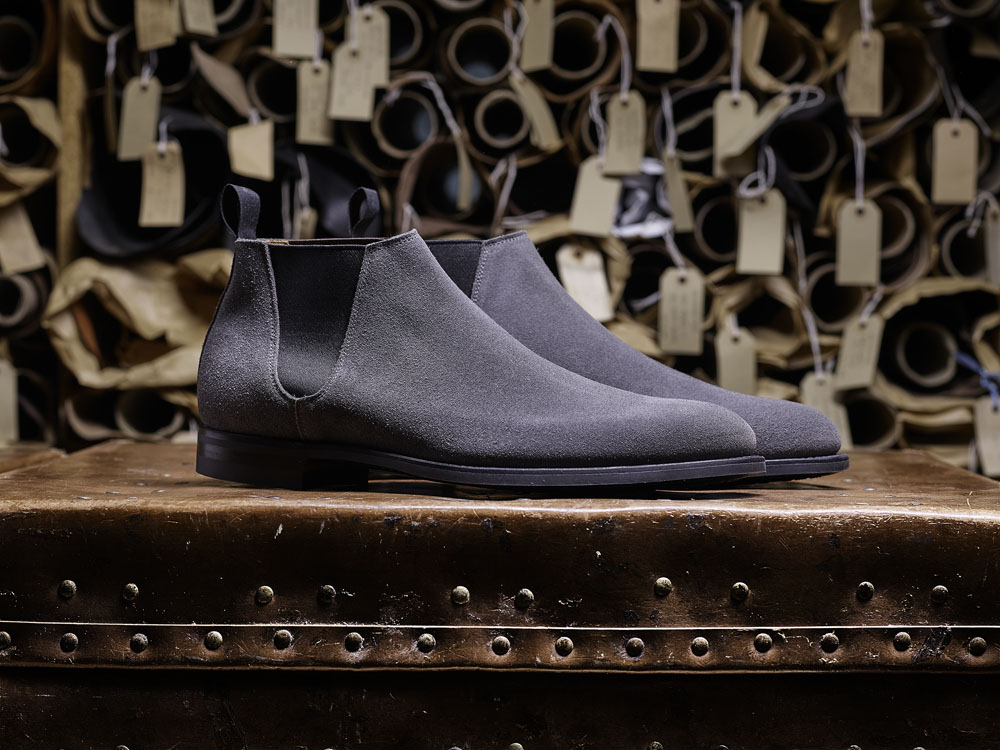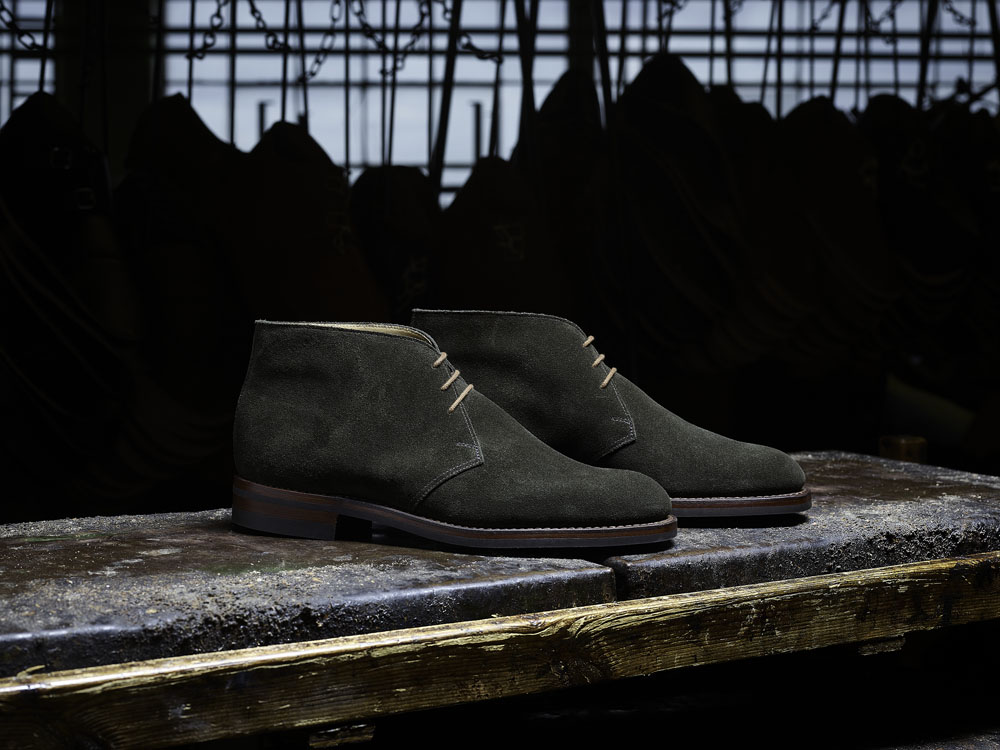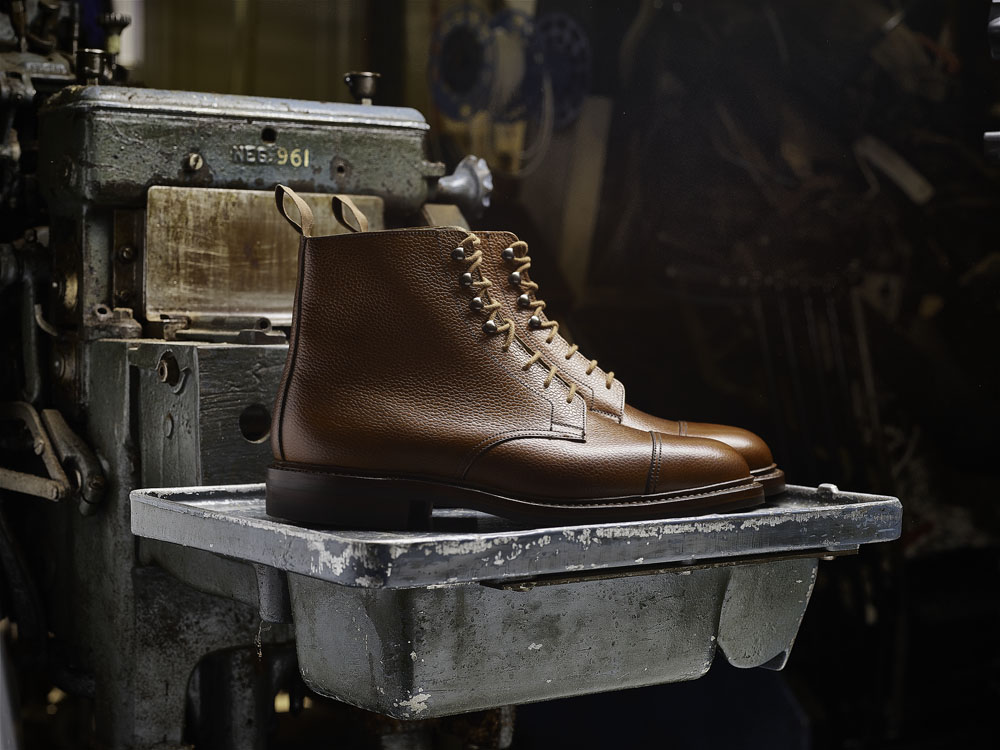Only few classical menswear brands enjoy such unanimous approval as Crockett & Jones. Shoe lovers and competitors agree that the family owned manufacturer delivers an excellent product. In the past mainly for other labels, today mostly under the Crockett & Jones brand. Head of Marketing James Fox speaks about the reasons of this success and reveals some background information.
Bernhard Roetzel: First of all: What is the situation for C & J regarding Corona?
James Fox: The health and safety of our customers and staff remains paramount during this challenging time. Due to the ongoing global outbreak of Covid-19 we made the important decision to close all stores and the factory / head office operations in a bid to help slow down the spread of the virus. Although essential personnel will attend work to steer the business through this situation, current measures will remain in place as long as necessary, in line with Government guidelines.
Changing daily, the situation for businesses is complicated. At this time, our company directors are working through the available information to them, making sense of the recent financial support options from our Government. We are thankful that they finally recognised, taking lead from other European countries, that through all of this uncertainty people must remain employed and employers must receive support. Crockett & Jones are of course privately own, which enables us to make decisive decisions within a matter of days or even hours of developments. This will also aid us to get back up and running as soon as the sun shines once again.

C & J is presently one of the famous and prestigious shoe manufacturers from Northampton, if not the most famous. Is your reputation reflected in your market share?
I would say so, although it is difficult to quantify brand reputation. Most would not know that our production is ten times the size of some of our piers, but then some would see our brand and think our production is ten times the size that it is!
From the feedback we receive from many of our wholesale customers, retail staff and end consumers, the common denominator across all is that Crockett & Jones’ strategy to offer high quality, Goodyear welted shoes at a reasonable price (representing value for money), is working. In fact, to get our quality of materials and fit elsewhere you need to spend double our current retail price. That might sound a little outspoken, but this is the feedback that we are receiving from many, many customers and pays tribute to the core of our strategy and there is no doubt this translates into a positive market share. But, whilst our market share has grown over the past 20 years, the entire pie for goodyear footwear is the smallest is has ever been.
What sets you apart from the competition?
The value you can find in our products. The long-standing and deep-rooted respect our end consumers have for our products. Our lasts. Our patterns. Our service. Oh, and we have Jonathan Jones!

It seems that Spanish manufacturers are gaining in importance. Is that a true? And if that is so, is it a problem for you?
I think this is true to a point, but I would not have used the word importance. They are certainly well spread. Spanish manufacturers make good shoes. They also make a lot of shoes. When you talk about importance you must seek the root of the oak tree, not the branches. Importance refers to those who laid the foundations for Goodyear footwear, who developed and adopted the production method and created those iconic styles we all know and sell today. Those footwear industries are the top end English and American makers who we’d argue, provide the inspiration for most of the styles that come out of Spain. The highly respected manufacturers in England and North America will always remain at the forefront of importance, the roots of the footwear industry. Thankfully, our forefathers were not just incredible shoemakers, they were also excellent businessmen.
In recent times, a lot of growth that the Spanish makers are seeing is coming from their over-distribution online and the explosion in small startup brands who manufacturers like Church’s, Crockett & Jones, John Lobb more than likely inspired. These brands cannot afford to have their shoes produced in England and are therefore forced to compromise on quality to remain within budget. They will be owned by English / America Goodyear customers who have either jumped on the bandwagon of the rise in sales Goodyear shoes has seen of late, or more likely (hopefully) are owned by people with a passion for Goodyear shoes. A number of these brands are based in Scandinavia and there is no doubt that they have impacted on sales in that region.
On a global scale, this has all been very positive for the industry as a whole as a lot of these brands are very savvy online. We would rather a customer read about and wear a pair of Goodyear welted shoes sold by a brand, made by a craftsman or craftswoman in Spain, than a pair of cemented shoes made in a mass production facility where the products are simply churned out in droves. This customer might choose an English maker for their 2nd or 3rdpurchase.
One negative: I do hate the marketing slogan of some of these fledgling brands ‘cut out the middlemen’. This undermines decades of customer education and service and I am sorry to report that unless you are a manufacturer, you cannot cut out the middleman. If you are simply a retail brand, regardless as to whether you sell in a physical retail store or on a web shop, by default you are the middleman (between the manufacturer and consumer). Wholesale is simply one more middleman, which in our industry makes for long-term and satisfied customers. Without our wholesale network of worldwide retailers, the top end shoe trade would be a fraction of the size. These new kids on the block would do well to remember that…
Manufacturers that allow their pure-play retailers (online only) to market themselves in this unnecessarily aggressive manner, will eventually damage their own wider network of retailers and probably their own brand.

How many shoes do you make per year?
Crockett & Jones’ production figures are regularly above 100,000 pairs per year.
This is an impressive number. How do you secure the quality?
A skilled labour force and a conscientious production management team. We are also very well respected among our suppliers which ensures we get a regular and high-quality supply of all components that are utilised during the 8 week production process, none more important than upper leather.
What is the difference between the standard collection and the Hand Grade collection?
Mainly two weeks… Slight differences between the ranges set one apart from the other making The Hand Grade Collection from Crockett & Jones one of the finest, highest quality ready-to-wear shoes from England today. I do wish I could tell you a secret, but I cannot…
Hand Grade Collection: An asymmetric last, shaped to the natural contours of the foot, gives exceptional fitting qualities. Uppers cut from the finest calf skins with a supple tannage, provide glove like comfort. Fine aniline dyes in the leathers and extensive hand polishing of the finished shoes, creates a rich depth of colour which will be enhanced with age if regularly polished and cared for. Soles that have been slowly tanned with natural barks, in the most traditional way, have superior comfort and flexibility. The hand of our skilled craftsmen can be appreciated in the fine stitch detailing of the uppers and the expert way the soles are trimmed and stitched before the final wax polishing: a process which lasts up to 10 weeks.
Main Collection: The Men’s Main Collection from Crockett & Jones encompasses a wide range of elegant calf styles for city wear, as well as country shoes and boots, house slippers and driving shoes. This assortment of footwear with leather or rubber soles is made from the finest leathers, including aniline calf, suede, country grains and specialised waxed leathers. Hand-crafted by the traditional Goodyear welted construction, Crockett & Jones shoes have an exceptional combination of comfort, elegance and longevity in wear. Each pair takes up to 8 weeks to manufacture in a process involving over two hundred separate operations.
*This was taken from an article I personally wrote on our website in 2012.
Is the private label business very important for you?
All business is important to us.
Private label production has never been at its lowest level in the history of Crockett & Jones. This is mainly due to the growth of the Crockett & Jones brand. Jonathan Jones took the decision to step up our own branded production in the early 90s, which by the end of the decade saw him launch his first branded flagship on London’s most famous menswear street, Jermyn street. This has since translated into 14 retail stores, with our original store still going strong.
The other determining factor is simply that many of our private label brands have either disappeared or are taking the decision to cheapen their product offering by chasing margins. We do not have to agree with the lack of respect they show towards their customers, but we do have to respect their decisions to seek product elsewhere.
We cannot fathom that in a time where companies are at their most transparent (the era of the internet), how can a retail brand choose to make its products in a mass production facility yet uphold and sometimes even increase their retail prices? Crazy… but that is what happens when you remove the product teams from a product led businesses…
You are famous for Goodyear welted shoes. Are you limited in your possibilities by this construction method?
To a point, but we prefer to specialise in Goodyear welted footwear and focus on being the best we possible can be. We want customer to return to us for another pair of Goodyear shoes because their first pair was so damn good, they simply have no choice but to buy another!
We have the cash reserves (for now!) to expand into other products and even production methods, some of which we used to use. However, it takes away the mantra of the business that our Managing Director steers his ship with: To produce high quality, excellent fitting goodyear welted shoes, that represents value for money to our customers.
Never say never, as nobody knows what the future holds. We feeling this more so now than ever! For now, we are quite comfortable with not chasing unsustainable growth through extended and largely irrelevant product collections. Better to have the greatest collection of Goodyear welted shoes! You don’t see New Balance producing Goodyear shoes, so why should we try to make sneakers.
Some Italian makers use other construction to make shoes that look similar to Goodyear welted ones but cost less. What is the advantage of Goodyear welted compared to Blake.
Goodyear welted shoes are longer-lasting, hold their shape better and are fully repairable. Blake stitched shoes are less expensive for a reason and although they are sold as being more comfortable, unlined lightweight goodyear is as comfortable as a shoe needs to be without being a sneaker or a slipper.
We prefer the look and feel of a goodyear shoe. Next time you are in a retail store, pick up one of each and then tell me which you’d invest in… I know where I would put my money.
In the late 19th Century sewing or woodpegging were the only known techniques, cementing came much later. Has the Goodyear welted process changed or improved in recent decades?
Not really, a few components materials have moved on such as the toe puff, which is now a heat-setting resin and material mix. The goodyear welted construction method has stood the test of time.
I would say the two major developments of late are the introduction of flexible rubber soles, the City sole in the case of Crockett & Jones, and the increase in demand for unlined styles, particularly Loafers. If you haven’t tried a pair of our unlined suede Loafers shod in the City rubber sole, you must. Immediately!! I live in mine the second the temperature reaches 15 degrees… and no, the rubber sole does not heat my foot up.
C & J is also a retailer with your shops and online. Has this ever been a problem for your retail customers?
In the early days, I heard stories that the retail stores were a conflict of interest for many, but our wholesale customers soon came to realise that we are all of the same team, representing the same brand. The brand awareness growth that our own retail stores have driven over the past 20 years surpasses any advertising the company had done prior to launching its website 2011 and then social media thereafter. Our online revenue is quite small, as it currently operates as a Mail Order service. The disruption is minimal.
E-commerce is something that the brand must embrace in the not too distant future. Even still, as long as our pricing strategy is correct the conflict should remain minimal. We will always encourage a new customer to seek out their local stockist if they have one.
There is a growing vegan movement. Will you offer a vegan pair of Goodyear welted shoes?
Not in our retail collection, but we have toyed with the idea in the past. This is particularly prevalent in Scandinavia, so we have made shoes that use only veg-tanned materials for our distributor there. It is not a growth area we wish to pursue although it was an interesting project.
Which trends do you see in the short term and in the long term?
Boots. Loafers. Classics with rubber soles. Unlined styles. Excellent Fitting & Comfort.
How can you win over young people to your style of shoes?
Very interesting question and one that you use a PHD topic!
We believe there will always be a customer for the classics in menswear and as the world become less formal there will remain a place for Goodyear welted shoes. The icons as we refer to them have too much historical reference to be forgotten or overlooked and styles such as unlined loafers and suede chukka boots are too comfortable to never be consider for the wave of smart casual clothing (separates) on sale today.
By remaining committed to the products we offer and not making grand changes to our product lines, I believe we instill customer confidence and customer loyalty which breeds word of mouth referrals. We really benefit from the Patek Philip mindset that your father passes on his knowledge… of excellent footwear to his sons and daughters… although we’d recommend buying a new pair rather than handing them down!
Price point is an important factor in attracting younger customers, you can experience a pair of our shoes for £370 and many customers see that as an great investment. For our quality that price is incredible. I still have shoes I purchased 10 years ago. One resole and many polishes later, they still look great. I’d happily pay a lot more than £50 a year for a pair of our shoes… (£400 shoes £100 resole) Finally, and the more obvious answer is through our marketing. We have a very interesting website, strong social media following, wonderful relationships with our media partners and put a lot of effort into the endless generation of new content. Articles such as those provided by our Guest Authors, that you kindly participate in, have proven to be a great success.

